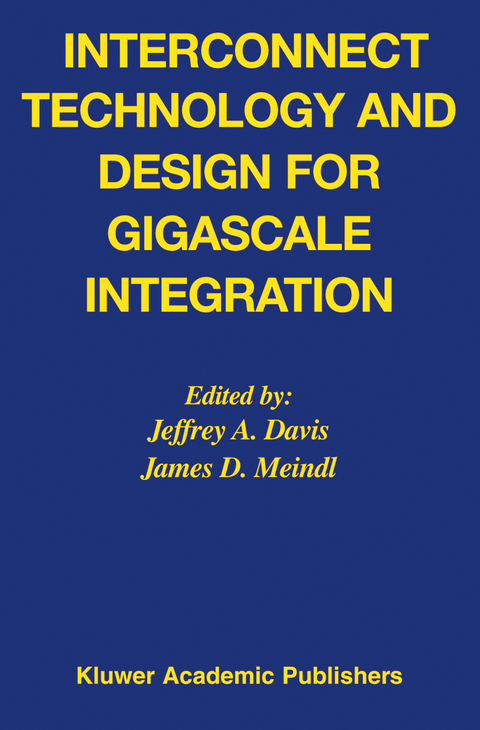
Interconnect Technology and Design for Gigascale Integration
Springer-Verlag New York Inc.
978-1-4020-7606-0 (ISBN)
1. Interconnect Opportunities for GSI.- 1.1 Introduction.- 1.2 The Interconnect Problem.- 1.3 Reverse Scaling.- 1.4 System-on-Chip.- 1.5 Three-Dimensional Integration.- 1.6 Input/Output Interconnect Enhancements.- 1.7 Photonic Interconnects.- 1.8 Conclusions.- 2. Copper BEOL Interconnects for Silicon CMOS Logic Technology.- 2.1 Introduction.- 2.2 BEOL Evolution.- 2.3 The Case for Copper.- 2.4 Electroplating of Cu.- 2.5 Reliability of Cu Interconnects.- 2.6 Processing of Cu Interconnects.- 2.7 Summary.- 3. Interconnect Parasitic Extraction of Resistance, Capacitance, and Inductance.- 3.1 Introduction.- 3.2 Electromagnetic Formulation.- 3.3 Resistance Extraction.- 3.4 Capacitance Extraction.- 3.5 Inductance Extraction.- 3.6 Summary.- 4. Distributed RC and RLC Transient Models.- 4.1 Introduction.- 4.2 Distributed RC Models.- 4.3 Distributed RLC Models.- 4.4 Non-Ideal Return Paths.- 4.5 Summary.- 5. Power, Clock, and Global Signal Distribution.- 5.1 Introduction.- 5.2 Global Signal Interconnect Modeling.- 5.3 Global Clock Distribution Modeling.- 5.4 Global Power Distribution Modeling.- 5.5 An Integrated Architecture for Global Interconnects.- 5.6 Conclusions.- 6. Stochastic Multilevel Interconnect Modeling and Optimization.- 6.1 Introduction.- 6.2 Wire-Length Distribution Model.- 6.3 Net Model Approximation.- 6.4 Comparisons with Actual Data.- 6.5 Critical Path Model.- 6.6 Dynamic Power Dissipation Model.- 6.7 Optimal n-Tier Multilevel Interconnect Architectures.- 6.8 Summary.- 7. Interconnect-Centric Computer Architectures.- 7.1 Introduction and Motivation.- 7.2 Interconnect-Aware Architectures.- 7.3 Interconnect Demand Models.- 7.4 Related Work.- 7.5 GENESYS Organization and Models.- 7.6 Heterogeneous Architecture Models.- 7.7 System Design Analysis.- 7.8 Wire Demands andtheir Relation to Architecture.- 7.9 Conclusion.- 8. Chip-to-Module Interconnect.- 8.1 Introduction.- 8.2 Packaging and Chip-to-Module Trends.- 8.3 Microvia Printed Wiring Board Technologies.- 8.4 Chip-to-Module Interconnections for GSI.- 9. 3-D ICs DSM Interconnect Performance Modeling and Analysis.- 9.1 Introduction.- 9.2 Motivation for 3-D ICs.- 9.3 Scope of This Study.- 9.4 Area and Performance Estimation of 3-D ICs.- 9.5 Challenges for 3-D ICs.- 9.6 mplications for Circuit Design and System-on-a-Chip Applications.- 9.7 Overview of 3-D IC Technology.- 9.8 Conclusions.- 10. Silicon Microphotonics.- 10.1 Introduction.- 10.2 Optical Interconnection.- 10.3 Monolithic Silicon Microphotonics.- 10.4 Optical Clock Distribution and Data I/O.- 10.5 Summary.
| Zusatzinfo | XIII, 411 p. |
|---|---|
| Verlagsort | New York, NY |
| Sprache | englisch |
| Maße | 155 x 235 mm |
| Themenwelt | Informatik ► Weitere Themen ► CAD-Programme |
| Technik ► Elektrotechnik / Energietechnik | |
| ISBN-10 | 1-4020-7606-1 / 1402076061 |
| ISBN-13 | 978-1-4020-7606-0 / 9781402076060 |
| Zustand | Neuware |
| Haben Sie eine Frage zum Produkt? |
aus dem Bereich


